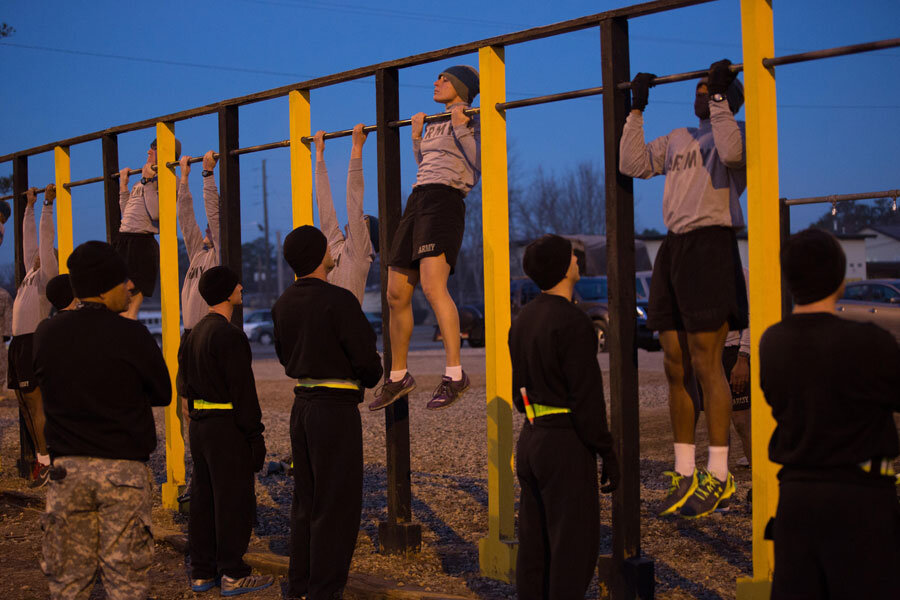What's it like for women soldiers in Ranger training? A glimpse inside.
Loading...
| Washington
Halfway through its preparations for the first-ever coed Ranger School in April, the Army took a moment to publicly take stock of how women are doing.
Eight military officials, one of them a woman, held a briefing Tuesday to talk about topics ranging from the need to add bras to soldiers' packing list to why more women (and men) than expected failed to complete the most recent Ranger Training Assessment Course (RTAC).
Female soldiers must pass the RTAC in Fort Benning, Ga., to enroll in Ranger School, the first US Special Operations Force school to open its doors to women. So far, six women have done it, with two courses finished and two remaining.
In all, 43 women have attempted the course, leading to a pass rate of 14 percent. The pass rate for men this year has been 45 percent (89 of 196). But the officials say that they have been encouraged by the spirit of camaraderie displayed by the women.
Yet officials say they were struck by the fact that the women “decided they wanted to continue to train,” said Maj. William “Shep” Woodard, a company commander with the United States Army National Guard Warrior Training Center at Fort Benning. He called the decision “noteworthy.”
The remaining woman, whom the Army has not named, “did have support the entire time,” said Sgt. 1st Class Joshua Eaton, a Ranger instructor. “It wasn’t her against the world.”
At this point, even if women do pass Ranger School in April, they will not be able to serve in the Army's most elite unit. The military ban on women in combat remains, though a review is expected to be completed by next January. Earning a prestigious Ranger tab, however, would be a historic achievement.
Officials are already doing what they can to make sure prospective women Rangers are treated equally. All aspiring Rangers at Fort Benning share the same barracks, regardless of sex. The 1970s-era facilities include buildings that have just one latrine – leading to prescheduled times in which men or women can use the bathroom.
Male soldiers are gradually adjusting to the presence of women in the course, said Sgt. 1st Class Tiffany Easter, who is assigned as one of the female observer/advisers for the program.
“A lot of the Rangers have never worked with females before, so they are not sure how to handle issues” such as “personal hygiene and things like that,” she said.
For their part, the officials had to remember to make additions to the usual list of items for soldiers to pack. “We’ve never had women attend, so we’ve had to add bras,” said Col. David Fivecoat, commander of the Airborne and Ranger Training Brigade.
In addition to making allowances for the women, the observers say they have also taken care to make sure women don’t receive special treatment during the course, “not intentionally, but just from the fact that they are a woman,” says Sergeant First Class Easter. “If we see anything like that, we’ll let the instructors know.”
The officials acknowledged that they were a bit disappointed with the pass rate from the February training session: 100 soldiers – 17 of whom were women – began the course, and 36 passed it, one of whom was a woman.
“The success rate was considerably lower” than for the average class, said Major Woodard.
“For whatever reason, this was an underperforming class for men and well as for women,” he added. “We don’t like to see that.”
Whether it was the weather or the fitness level of participants was still up for debate, the briefers said. “We’re looking pretty closely for that trend,” says Maj. Gen. Scott Miller, commanding general at Fort Benning.
Sergeant First Class Eaton hazarded a guess. “For the females, sometimes with their pushups it’s the form,” he said. “There are a few of them who do not have the physical capability” to perform 49 push-ups.
“We also have the same problem with male students that arrive at Ranger School – it’s not just the women,” added Colonel Fivecoat. “We lost at least three-score students yesterday for push-ups alone.”
To pass the physical fitness portion of the course, soldiers must also do six chin-ups, 59 sit-ups, and run 2.5 miles in 20 minutes.
The woman who passed in February is an Apache pilot and first lieutenant from Fort Carson in Colorado.
“She did well,” said Woodard. “I’d expect her to acquit herself pretty well at Ranger School.”







